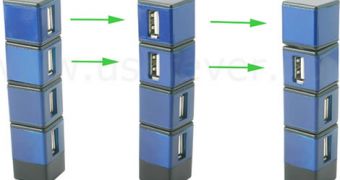The USB port is by far the most widely used and popular method of connecting different kinds of devices to a computer, from a mouse or a keyboard, to a Web camera, printer or MP3 player. While there are a number of other peripherals connectivity standards around - like the FireWire standard - which offer better transferring speeds, the Universal Serial Bus (now at its 2.0 version) is still the most widely used and it can be found just in any connectible device. As the number of USB ports that can be integrated into a computer is somewhat limited, an additional device called USB hub appeared.
A USB hub is a simple device as its role is to gather a number of external USB ports and connect to the host computer system through a single port, thus increasing the total number of available ports. Most USB hubs come in the classical box shaped form and they offer between four and eight external ports. For users that need both a number of external USB ports and the possibility for mask or hide some of the cables, the blue USB 2.0 180? Swivel Hub offers the possibility to rotate two of the ports in order to face different directions.
The USB 2.0 180? Swivel Hub adds a total of 4 high speed USB 2.0 ports that are backward compatible with the older and slower USB 1.1 standard as well as a power LED indicator. It is fully compliant with the technical specifications of the USB 2.0 standard, so it will work seamlessly with all types of USB compatible devices, while offering data transfer speeds between 1.5 and 480Mbps. As it is compatible with the USB 2.0 standard, the external hub is also plug and play compatible, so no drivers are needed for it to work. In order to protect both the USB hub and the connected devices as well as the host computer system, the USB hub comes with an individual port over voltage protection. A number of A/C power adapters are also available for the different power zones around the world.

 14 DAY TRIAL //
14 DAY TRIAL //